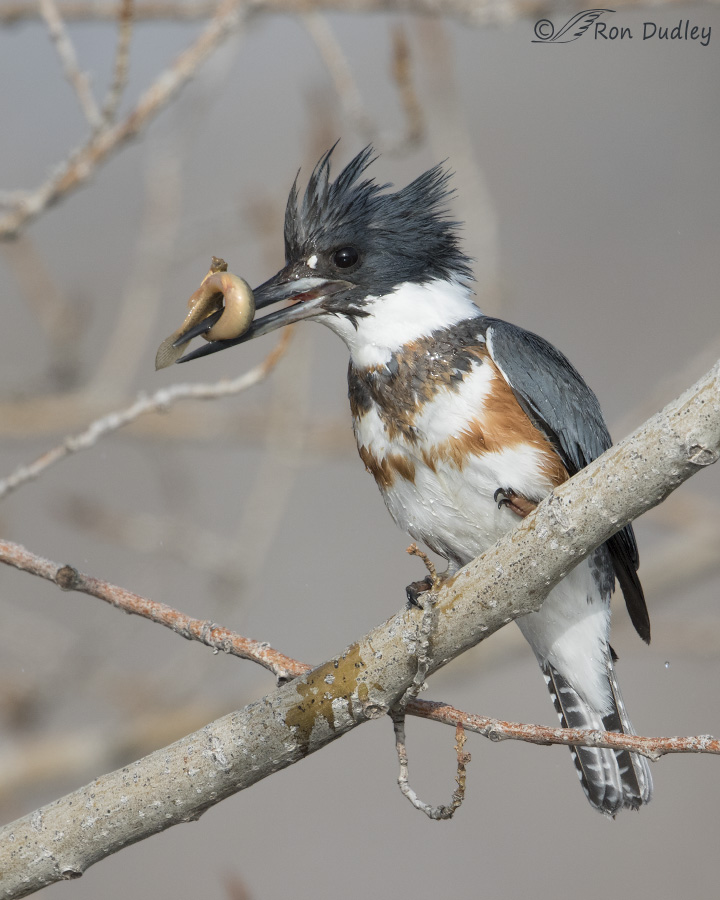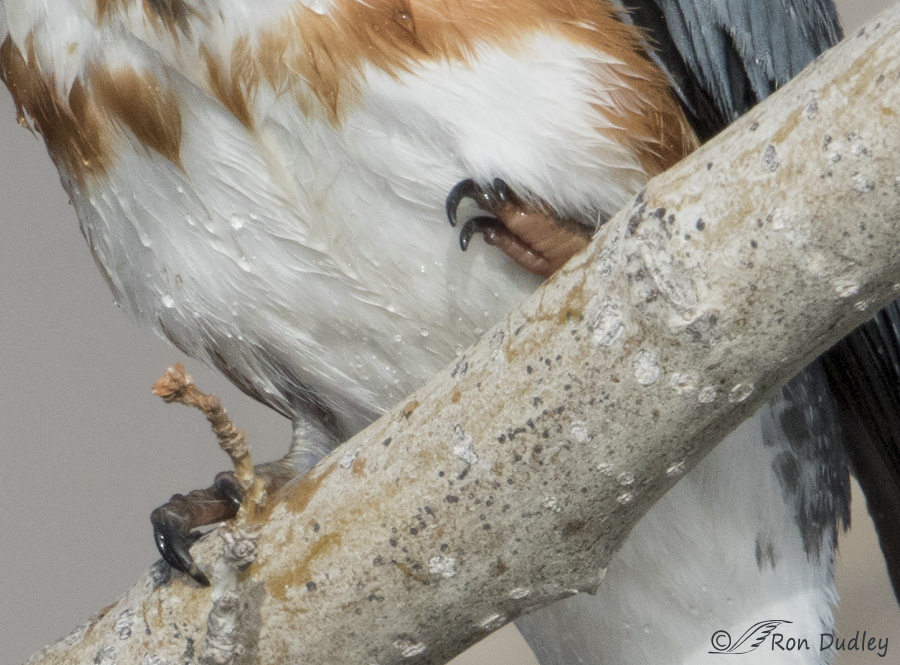I was hoping this female Belted Kingfisher would catch a fish and eat it close enough to me for good photos. She did not disappoint.

1/2000, f/7.1, ISO 500, Canon 7D Mark II, Canon EF 500mm f/4L IS II USM + 1.4 tc, not baited, set up or called in
I photographed her two days ago near the Jordan River as she repeatedly dived for fish. Only one time did she bring her meal in close enough on a perch that was relatively unobstructed to my view and I took many photos as she battered the fish against the branch she’s perched on, tossed it around a little and eventually swallowed it. This is one of my favorite images of the series because of the nice look at the coiled and struggling fish, the good light on the bird, the clutter in the background isn’t too distracting for my tastes and I like the raised left foot. I also like the little clues in the image that give hints as to what’s going on – the slimy wet spot on the perch where the kingfisher was slamming the fish into the branch in order to kill it and even the tiny water droplet falling off the left wingtip.
Some will notice the somewhat unusual eel-like shape of the fish. It’s a Weather Loach, an invasive fish species popular with aquarists and presumably released into the river when their owners could no longer care for them. Weather Loaches are now found in many of the fresh water streams and ponds near the Great Salt Lake. I first reported them here on one of my earliest blog posts – they have some very interesting natural history.

A huge crop of the previous image reveals a somewhat unique adaptation of the Belted Kingfisher. Notice that the two outer toes (most easily seen here in the raised left foot) are fused together almost to the claws which results in what appears to be a single, long, flattened toe with a broad sole in common (this trait is known as syndactyly). It provides a more robust digit that kingfishers use to dig their nesting burrows in the banks of streams. Pretty neat!
Sometime soon I plan on posting an entire series of this bird with the loach that includes some images of kingfisher fishing technique but that will have to wait until I finish my image culling and processing – in this case a daunting task.
Ron


Great Post and photos! I didn’t know about the toes…that’s most interesting.
Just wow Ron. Best KF pics ever!! So crisp, well lit…the full Monty on this one. I had never heard the term “syndactyly”, so thank you for sharing and letting us know what it is. Makes sense once you think about it…neat 🙂
Congrats, fantastic shots!
Charlotte
WOW! Fascinating! And good that the kingfishers are eating an invasive species. That works! What a COOL bird. But I say that about all the birds. I’m so easily amused and birds are magical critters! 😀
“And good that the kingfishers are eating an invasive species”
Agreed, Laura. I’ve photographed several of our birds eating loaches – including Pied-billed Grebes, Snowy Egrets and Common Goldeneyes.
Beauty and information. Delight and learning.
Another lovely start to my day. Thank you.
That’s a good combination for me too, EC. Thank you.
Thank you for the information on the Weather Loach. I have seen birds eating them but did not know what they were. Beautiful photo of the Kingfisher. For me they are a difficult bird to even observe. They are always so skittish I can’t wait for the others in the series.
I think they’re difficult for most folks, April. It’s just in their nature to be quite unapproachable.
Great job – good visual lesson!
I am envious of your chance to get so close that your crop is spot on!
“I am envious of your chance to get so close”
I was beginning to think it would never happen, Dick.
Another great photo accompanied by interesting information….wonderful. Thanks! I didn’t know where this bird nested, didn’t know the unique construction of their feet, and just realized that I’ve seen them perched on a branch overlooking a stream and seen them flying, but I never saw them actually catch a fish….Happy Valentine Day!
Patty, I saw this one catch several fish and I believe all of them were loaches. Hope you have a great Valentine’s Day too.
You made my day!! I really like this bird, but can never get close enough to observe it, even with my binoculars. (My 300 lens would never capture one!) Thanks so much!
Jane, even my 500mm plus teleconverter almost never gets me close enough to get decent kingfisher images. This was truly an exceptional event for me.
I so appreciate that you regularly point out and explain features like that adaptation–in the photo, it’s subtle enough that I know I wouldn’t have
noticed it without the help……
Thanks, Kris. This species has little feet so that’s one thing that makes the trait a little harder to spot.
Wonderful shots served up with a little education, as usual. Thank you. I’m certainly looking forward to the entire series.
Thanks, Gary. That series should come within a few days.
Great image Ron. We have plenty of Kingfishers in our area but they are very skittish and always in a hurry to be somewhere else. We agree that they are difficult birds to photograph. I’m impressed with the crisp sharpness of your images. Please keep ’em coming.
It’s nice to have that sharpness back again, Gary. It deserted me for a while…
Awesome image Ron! Fascinating adaptation! You can only wonder how long it took for this adaptation to occur.
I always think about the process of evolution when I see something like this, Nancy.
Fascinating!
Thanks, Sally.
Wow! Great shots of an elusive bird.
They’re elusive for sure, Dave, at least they have been for me. Thank you.
Incredible shots as usual, such beautiful detail.
I’m glad you like them Rich. Thanks.
Beautiful! I didn’t know about the adaptation tho I knew they dug into the creek bank for a nest and wondered how they could do that – both the digging and keeping their feathers clean!
Judy, Bee-eaters and Rollers have the same adaptation, I believe for the same reason.
Always a pleasure, Ron, to view the results of your labors!!! Thank you!!!!
Thanks very much, Lois.
Very cool! I do don’t know about that adaptation. 🙂
I think stuff like that foot adaptation is fascinating, Arwen.